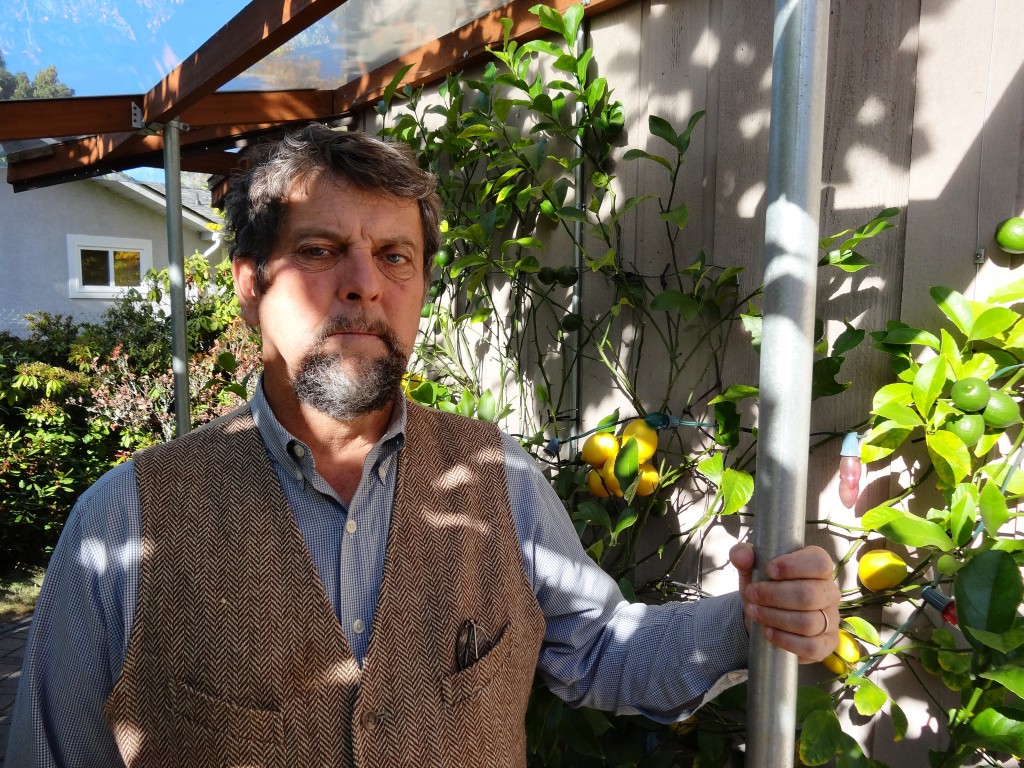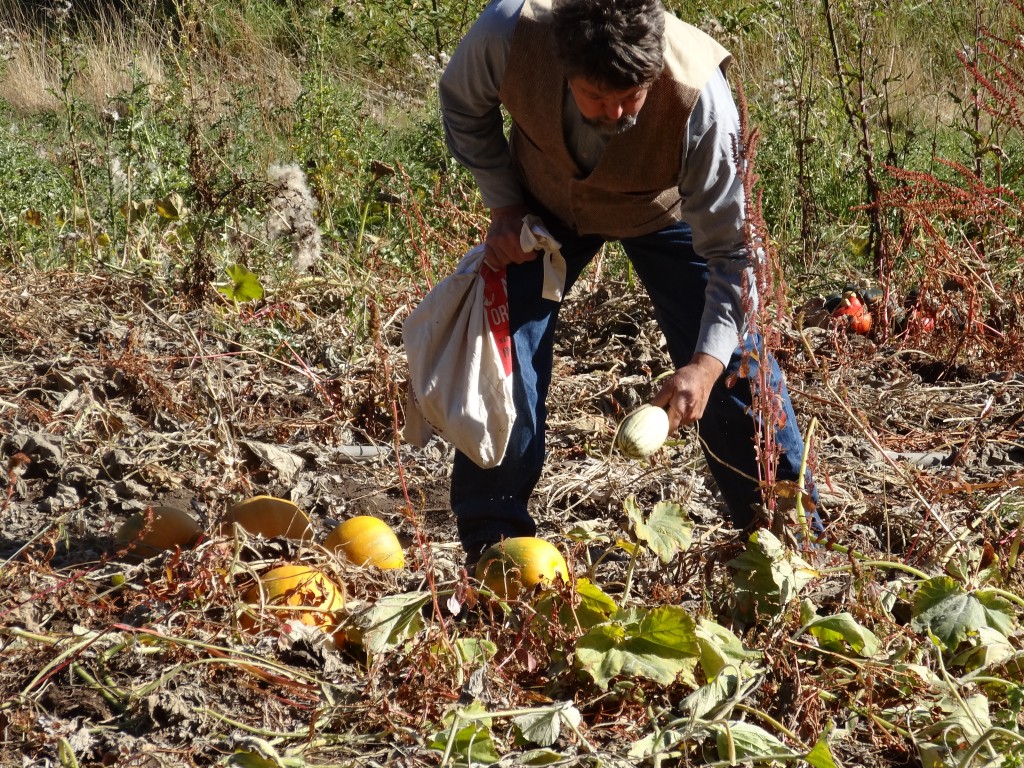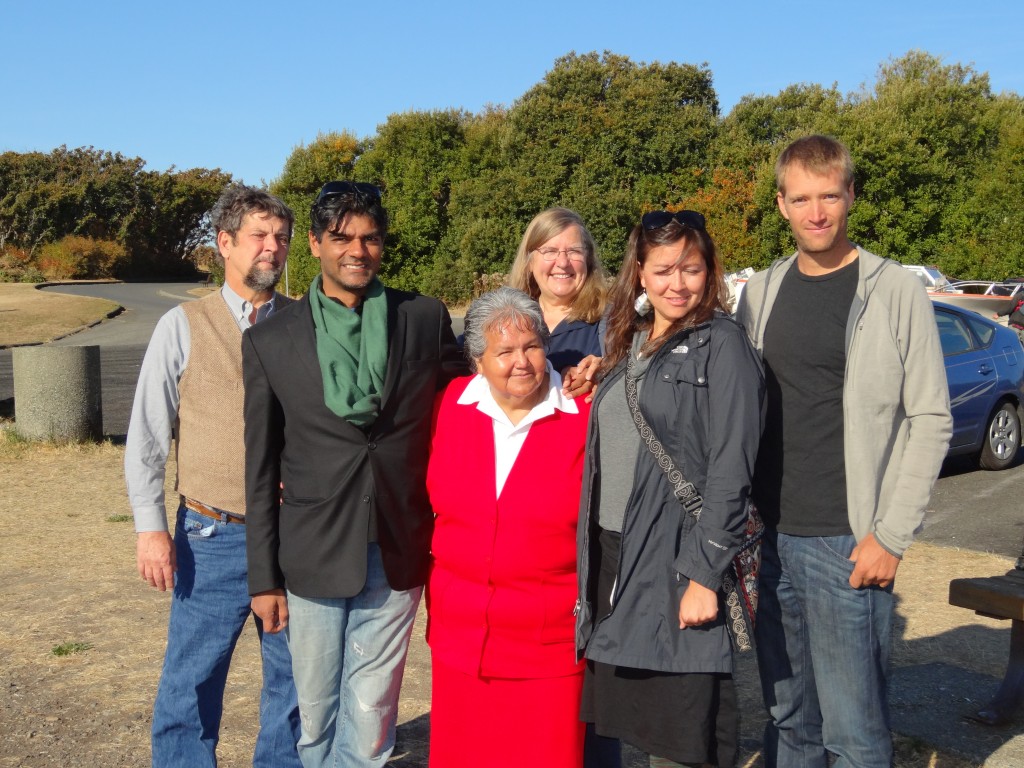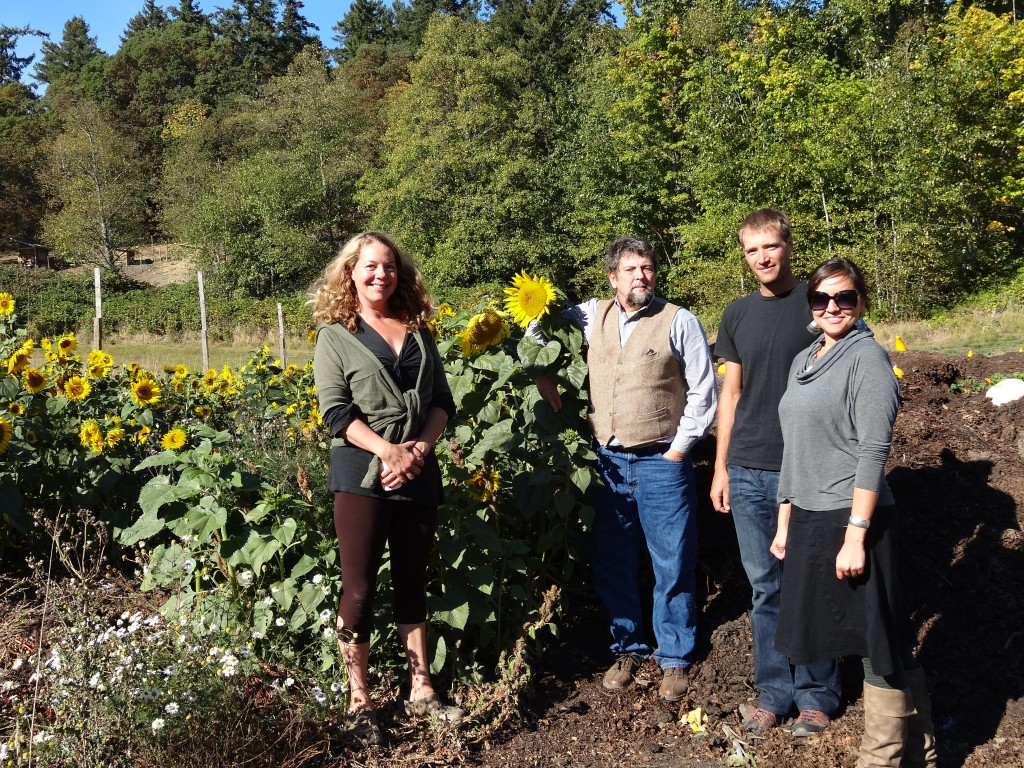
Gary standing beside Bob and Verna Duncan's lemon tree on the Saanich Peninsula (planted in anticipation of climate change) Gary debout à côté du citronnier de Bob et Verna Duncan sur la péninsule de Saanich (planté en prévision du changement climatique)
By/Par Dr. Nancy Turner. University of Victoria
Slow Food Vancouver Island
Crédits Photo credits : Dr. Nancy Turner
Does our genetic history make us more disposed to particular foods in our diets? Is there a reason why some populations are more susceptible to diabetes than others? Can we become healthier by relying more on the foods of our ancestors? These are all questions of interest to Slow Food Canada members, and on which world renowned food expert and ethnobiologist Dr. Gary Paul Nabhan has deliberated, especially in relation to the foods of desert dwelling indigenous peoples in different parts of the world. Most recently, he has focused much of his energy and practice to the present and future effects of climate change, especially as it impacts the relationships between food species and their pollinators.
Gary is no stranger to the Canadian food scene. His books and articles on the culture of food are widely known, especially in Slow Food circles. In early October, 2012 he delivered two inspiring lectures for the School of Environmental Studies at the University of Victoria: Regional Heritage Foods and Climate Change: The Scrambling of Terroir and its Implications for First Nations Food Security, and Landscape-level Pollinator Recovery, Food-chain Restoration & Citizen Science. These talks, the first of which was also sponsored by the Horticultural Centre of the Pacific, represent the summation of his thoughts on food security in a changing world, and what can be done to restore the critical connects between human cultures, food systems and the earth’s ecological systems that support all of us.
As a pioneer in the Local Food Movement, Gary is widely celebrated for his research, insights and activism on food. For example, he was named one of Utne Reader’s Twelve Innovators Making the World a Better Place to Live in, and in 2001 he was awarded the Lifetime Achievement Award by the Society for Conservation Biology, and 2007, he received the Quivira Coalition’s Outstanding Leadership Award in Research. Currently he holds the Kellogg Endowed Chair in Food and Water Security in the Southwest Borderlands, at the Southwest Center, University of Arizona, in Tucson. His lectures and his numerous books directly reflect the philosophies and concepts embraced by the Slow Food movement, and he has, in fact, worked closely with Slow Food at many levels. He has taught courses for the University of Gastronomic Sciences at Pollenzo, Italy, and, as founder and facilitator of the Renewing America’s Food Traditions Alliance, Co-founder Sabores Sin Fronteras Foodways Alliance and Past Research Director of Native Seeds/SEARCH, he has worked tirelessly for decades to promote local, indigenous foods, crop diversity, and food sovereignty.
Gary received his PhD in Arid Lands Resource Sciences at the University of Arizona in 1983. For the past several decades, as an ethnobotanist, Gary has been interviewing and working with desert farmers “who grow food that has listened to drought and heat” in the Gobi, Sahara, Arabian Peninsula, Sonoran and Painted Deserts to understand their strategies and practices for adapting to climatic uncertainty. At the same time, he has been inventorying traditional “heritage” foods of First Nations peoples – both wild and cultivated – that are already or potentially affected by climate change and worthy of being honored on the Slow Food International Ark of Taste. With 2012 standing as the year in modern history with the most climatically-related yield disruptions and declarations of drought disaster areas in Canada, the U.S., and Mexico, Nabhan feels compelled to review how food traditions are being affected by climate change, and how returning to traditional ecological and agricultural knowledge can inspire solutions and adaptations to stave off food security crises.
Since 2000, Gary has authored or edited numerous articles and papers, and no less than 17 books, all about different aspects of food and food security. It is no wonder that his work is so widely celebrated in the food world! One of my personal favourites, published in 2004, is: Renewing America’s Food Traditions: Saving and Savoring the Continent’s Most Endangered Foods (co-edited with Ashley Rood; Chelsea Green Publishing, White River Junction, VT), for which Gary was editor and contributor. Accompanying this overarching treatment of America’s endangered foods is a series of more regional treatments, including Renewing the Food Traditions of Salmon Nation, (2006), for which Dr. Sinclair Philip of Slow Food Canada and I were also contributors along with many others, through a workshop in Portland, Oregon sponsored by Ecotrust. Sinclair and Frederique Philip were happy to host Gary during his visit to Vancouver Island with a fabulous Sooke Harbour House lunch and mushroom hunting adventure.
Other Nabhan books include: Coming Home to Eat: The Pleasures and Politics of Local Foods (2001); Why Some Like It Hot: Food, Genes and Cultural Diversity (2004); Five Ways to Value Western Landscapes (co-editor) (2007); Arab/American: Landscape, Culture and Cuisine in Two Deserts (2008); Where Our Food Comes From: Retracing the Vavilov Through the Centers of Diversity In His Quest to End Famine (2008); Chasing Chiles: Hot Spots on the Pepper Trail (2011). For more information on Gary’s achievements and publications, see here.
As well as giving his compelling lectures at the University of Victoria, while he was here, he had a chance to connect with his friend and colleague – and another well known food activist – Dr. Raj Patel, author of Stuffed and Starved: Markets, Power and the Hidden Battle for the World’s Food System, who was giving a public talk for the Horticultural Centre of the Pacific. Also visiting Victoria at the same time were Gary Nabhan’s former doctoral student, now Dr. Kanin Routson, who completed his doctoral dissertation this year on “Malus Diversity in Wild and Agricultural Ecosystems”, and Valerie Segrest, a tribal cook and native foods educator for the Northwest Indian College in Bellingham, Washington, and member of the Muckleshoot tribe of Native Americans. Valerie teaches and facilitates many workshops on food security and food sovereignty, and is co-author (with Elise Krohn) of Feeding the People, Feeding the Spirit: Revitalizing Northwest Coastal Indian Food Culture, published in 2009.
We had a chance to tour the Horticultural Centre of the Pacific, near Victoria, and to witness their amazing gardens and learn about their promotion of agroecology and educational programs on horticulture, ethnobotany and native plant propagation. Our American visitors had the opportunity to experience a Canadian Thanksgiving, and during part of their time in the Victoria area they were accompanied by Songhees Nation elder Joan Morris, Sellemah, who has been a strong promoter of healthy Indigenous food within her own Nation, and enjoyed sharing stories and experiences with Gary and the others.
Of course, we all visited Sinclair and Frederique Philip and had lunch at Sooke Harbour House, where Gary and Raj were able to tour the beautiful edible gardens. The dishes – especially the edible flower salads – were spectacular. This was followed by a forest walk with Roger Charles, the Director of the Horticultural Centre of the Pacific. We also toured the amazing orchard of Bob and Verna Duncan on the Saanich Peninsula. Alongside dozens of heritage varieties of apples, pears, plums and other temperate fruits, including kiwi, Bob is growing varieties lemons, oranges, figs, persimmons and other semi-tropical fruits, using Christmas lights wired to thermostats to carry them through the coldest days of the winter. Gary was most interested to see Bob’s innovative strategies for growing these tree fruits, as, perhaps an advanced adaptation to the onset of climate change in Canada. We also toured Madrona Farm, an organic farm operated by Natalie and David Chambers, two energetic farmers who have hosted some sensational food events, such as the fifth annual Chef Survival Challenge on September 30th of this year, in which the “hottest chefs in Victoria” participated in a competitive and fun “culinary arts performance,” with 100% of the proceeds going to farmland conservation. Gary was able to pick squashes and greens from the Madrona Farm fields to create a wonderful stuffed squash with wild rice dish for our Thanksgiving dinner. What better way to celebrate a Slow Food hero than with a Slow Food weekend, and a sharing of experiences and ideas about how to keep our food systems and communities healthy?
See more photos here.

Gary Nabhan harvests squash for Canadian Thanksgiving dinner at Madrona Farms, a local organic farm fun?? by David and Natalie Chambers in Victoria. Gary Nabhan récolte des courges pour l'Action de Grace Canadienne à Madrona Farms, une ferme locale biologique fondé par David et Natalie Chambers à Victoria. Photo credit: Dr. Nancy Turner
Est-ce que notre histoire génétique nous rends plus enclin à certains aliments dans notre alimentation? Y at-il une raison pour laquelle certaines populations sont plus vulnérables au diabète que les autres? Pouvons-nous etre plus en santé en comptant davantage sur les aliments de nos ancêtres? Ce sont toutes les questions d’intérêt pour les membres de Slow Food Canada, et sur lesquellles l’experte de l’alimentation de renommée mondiale et ethnobiologiste Dr Gary Paul Nabhan a délibéré, en particulier en ce qui concerne les aliments des populations autochtones habitant le désert dans différentes régions du monde. Plus récemment, il a consacré une grande partie de son énergie et de sa pratique en ce qui concerne les effets actuels et futurs des changements climatiques, spécialement sur l’impact des relations entre les espèces alimentaires et leurs pollinisateurs.
Gary n’est pas étranger à la scène alimentaire canadienne. Ses livres et articles sur la culture des denrées alimentaires sont largement connus, en particulier dans le milieux de Slow Food. Au début octobre, 2012, il a donné deux conférences inspirantes pour School of Environmental Studies at the University of Victoria: Patrimoine régional des aliments et changements climatiques : Le brouillage du terroir et ses implications pour la sécurité alimentaire des Premières Nations et Rétablissement des pollinisateurs à l’échelle du paysage, restauration de la chaîne alimentaire & citoyen de la science. Ces pourparlers, dont le premier a été parrainé par le Horticultural Centre of the Pacific, représente le résumé de ses réflexions sur la sécurité alimentaire dans un monde en mutation, et ce qui peut être fait pour rétablir la connection critique entre la culture humaine, les systèmes alimentaires et les systèmes écologiques terrestres qui nous prends en charge.
En tant que pionnier dans le Local Food Movement, Gary est largement reconnu pour sa recherche, idées et activisme sur les denrées alimentaires. Par exemple, il a été nommé l’un des Utne Reader’s Twelve Innovators Making the World a Better Place to Live in . En 2001, il a reçu le Lifetime Achievement Award de la Society for Conservation Biology et en 2007, le Quivira Coalition’s Outstanding Leadership Award in Research. Actuellement, il occupe la Kellogg Endowed Chair in Food and Water Security in the Southwest Borderlands, au Southwest Center, University of Arizona, à Tucson. Ses conférences et ses nombreux livres qui reflètent directement les philosophies et concepts embrassés par le mouvement Slow Food , il a, en fait, travaillé en étroite collaboration avec Slow Food à de nombreux niveaux. Il a enseigné à l’Université des Sciences Gastronomiques de Pollenzo, Italie, et, en tant que fondateur et animateur de la Renewing America’s Food Traditions Alliance, Co-founder Sabores Sin Fronteras Foodways Alliance and Past Research Director of Native Seeds/SEARCH, il a travaillé sans relâche pendant des décennies pour promouvoir les aliments locaux et autochtones, la diversité des cultures et la souveraineté alimentaire.
Gary a obtenu son doctorat en Arid Lands Resource Sciences à University of Arizona en 1983. Durant les dernières décennies, en tant qu’ ethnobotaniste, Gary a interrogé et travaillé avec les agriculteurs du désert “qui cultive les aliments qui ont subit la sécheresse et la chaleur” dans le désert de Gobi, Sahara, Péninsule Arabique, Sonoran et Painted Deserts pour comprendre leurs stratégies et pratiques pour s’adapter à l’incertitude climatique. En même temps, il a fait l’inventaire du “patrimoine” des aliments traditionnels des Premières nations – le sauvage et le cultivé – qui sont susceptibles ou déjà touchés par les changements climatiques et digne d’être honoré à l’Arche du Goût de Slow Food International. Avec 2012 comme l’année de l’histoire moderne avec le plus de perturbations climatiques liées aux déclarations de la sécheresse dans des zones au Canada, aux États-Unis et le Mexique, Nabhan se sent obligé d’examiner comment les traditions alimentaires sont touchés par les changements climatiques, et comment retourner à l’agriculture traditionnelle et écologique peut inspirer des solutions et des adaptations pour conjurer les crises sur la sécurité alimentaire.

Gary Nabhan with Raj Patel, Joan Morris (Sellemah, elder of the Songhees Nation in Victoria), Nancy Turner, Valerie Segrest (of the Muckleshoot Nation, Washington) and Kanin Routson, who did his PhD on apple genetics under Gary's supervision, finishing earlier this year. Photo credit: Dr. Nancy Turner
Depuis 2000, Gary a écrit ou édité de nombreux articles et documents, et pas moins de 17 livres, tous sur différents aspects de la nourriture et de la sécurité alimentaire. Il n’est pas étonnant que son travail est si largement célébré dans le monde de l’alimentation! Un de mes favori, publié en 2004, est: Renewing America’s Food Traditions: Saving and Savoring the Continent’s Most Endangered Foods (co-edited with Ashley Rood; Chelsea Green Publishing, White River Junction, VT pour lequel Gary est rédacteur et collaborateur. Accompagnant cette analyse générale des aliments en voie de disparition en Amérique est une série d’analyses plus régionales, y compris Renewing the Food Traditions of Salmon Nation (2006), pour laquelle le Dr Sinclair Philip, de Slow Food Canada et moi étions collaborateurs avec beaucoup d’autres, par le biais d’un atelier à Portland, Oregon parrainé par Ecotrust. Sinclair et Frédérique Philip étaient heureux d’accueillir Gary lors de sa visite à l’île de Vancouver avec un déjeuner fabuleux au Sooke Harbour House et une aventure de chasse aux champignons.
Parmi les autres livres de Nabhan:
Coming Home to Eat: The Pleasures and Politics of Local Foods (2001); Why Some Like It Hot: Food, Genes and Cultural Diversity (2004); Five Ways to Value Western Landscapes (co-editor) (2007); Arab/American: Landscape, Culture and Cuisine in Two Deserts (2008); Where Our Food Comes From: Retracing the Vavilov Through the Centers of Diversity In His Quest to End Famine (2008); Chasing Chiles: Hot Spots on the Pepper Trail (2011).
Pour plus d’information sur les realizations et publications de Gary voir.
En plus de donner des conférences convaincantes à University of Victoria, alors qu’il était là, il a eu l’occasion de rencontrer son ami et collègue – un autre militant des aliments bien connu – Dr Raj Patel, auteur de Stuffed and Starved: Markets, Power and the Hidden Battle for the World’s Food System, qui donnait une conférence publique au Horticultural Centre of the Pacific. Également en visite à Victoria en même temps que Gary Nabhan était étudiant au doctorat, le Dr Kanin Routson, qui a terminé sa thèse de doctorat cette année sur « Malus Diversity in Wild and Agricultural Ecosystems “, et Valérie Segrest, un cuisinier tribal et un éducateur des aliments indigènes pour le Northwest Indian College in Bellingham, Washington et membre de la tribu Amérindienne Muckleshoot. Valérie enseigne et anime de nombreux ateliers sur la sécurité et la souveraineté alimentaire, et est co-auteur (avec Elise Krohn) de Feeding the Spirit: Revitalizing Northwest Coastal Indian Food Culture, publié en 2009.
Nous avons eu l’occasion de visiter le Horticultural Centre of the Pacific, près de Victoria et de voir leurs merveilleux jardins et d’apprendre au sujet de la promotion sur l’agro-écologie et des programmes éducatifs sur l’horticulture, l’ethnobotanie et la propagation des plantes indigènes. Nos visiteurs américains ont eu l’occasion de faire l’expérience d’une Action de Grâce canadienne, et pendant leur séjour dans la région de Victoria, ils ont été accompagnés par aîné Joan Morris a Native Songhees, Sellemah, qui a été un ardent promoteur de la santé alimentaire autochtone au sein de sa propre nation, et ont apprécié les histoires et expériences partagée par Gary et les autres.
Bien sûr, nous avons tous visité Sinclair et Frédérique Philip et avons déjeuné à Sooke Harbour House, où Gary et Raj ont pu visiter les magnifiques jardins comestibles. Les plats – en particulier les salades de fleurs comestibles – sont spectaculaires. Ce déjeuner a été suivi par une promenade en forêt avec Roger Charles, le directeur du Horticultural Centre of the Pacific. Nous avons également visité le verger étonnant de Bob et Verna Duncan sur la péninsule de Saanich. A coté des dizaines de variétés patrimoniales de pommes, poires, prunes et autres fruits de climat tempéré, comme le kiwi, Bob cultive variétés de citrons, oranges, figues, kakis et d’autres fruits semi-tropicaux à l’aide de lumières de Noël câblés à des thermostats afin de les mener à bien les jours les plus froids de l’hiver. Gary à plus d’intéret dans les stratégies innovatrices de Bob pour la culture de ces arbres fruitiers, comme, peut-être une adaptation de pointe pour le début du changement climatique au Canada. Nous avons également visité Madrona Farm, une ferme biologique exploité par Natalie et David Chambers, deux agriculteurs énergiques qui ont accueilli des événements alimentaires sensationnels tels que le cinquième défi annuel de Chef Survival Challenge le 30 septembre de cette année, dans laquelle “hottest chefs” à Victoria ont participé à une compétitive et amusante “culinary arts performance” . 100% des profits sont versés à la conservation des terres agricoles. Gary fut en mesure de cueillir courges et salades du champ de Madrona Farm pour créer une merveilleuse courge farcie de riz sauvage pour notre dîner de Thanksgiving. Quelle meilleure façon de célébrer un héros Slow Food qu’avec un week-end Slow Food, et un partage des expériences et des idées sur la façon de garder nos systèmes alimentaires et communautés en bonne santé?

Great article~